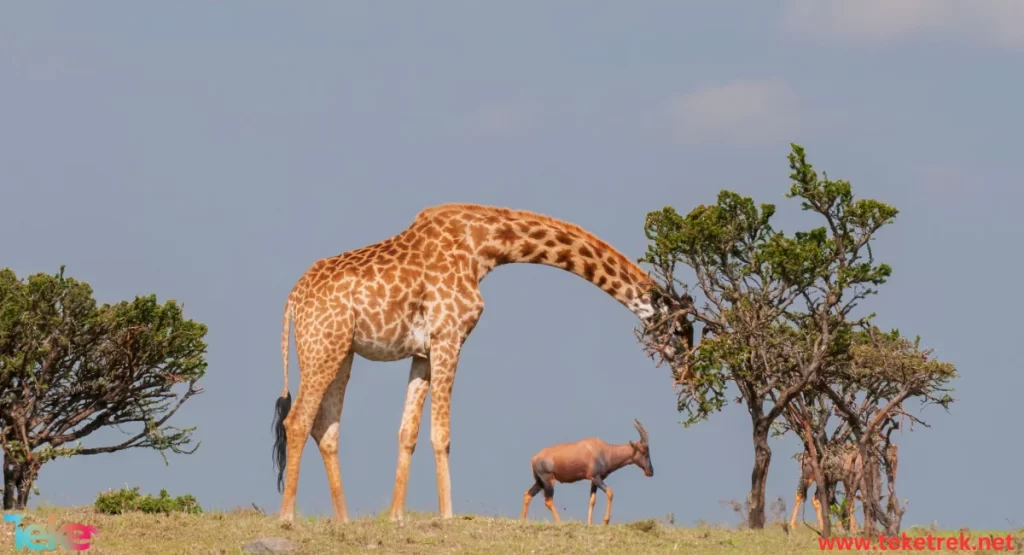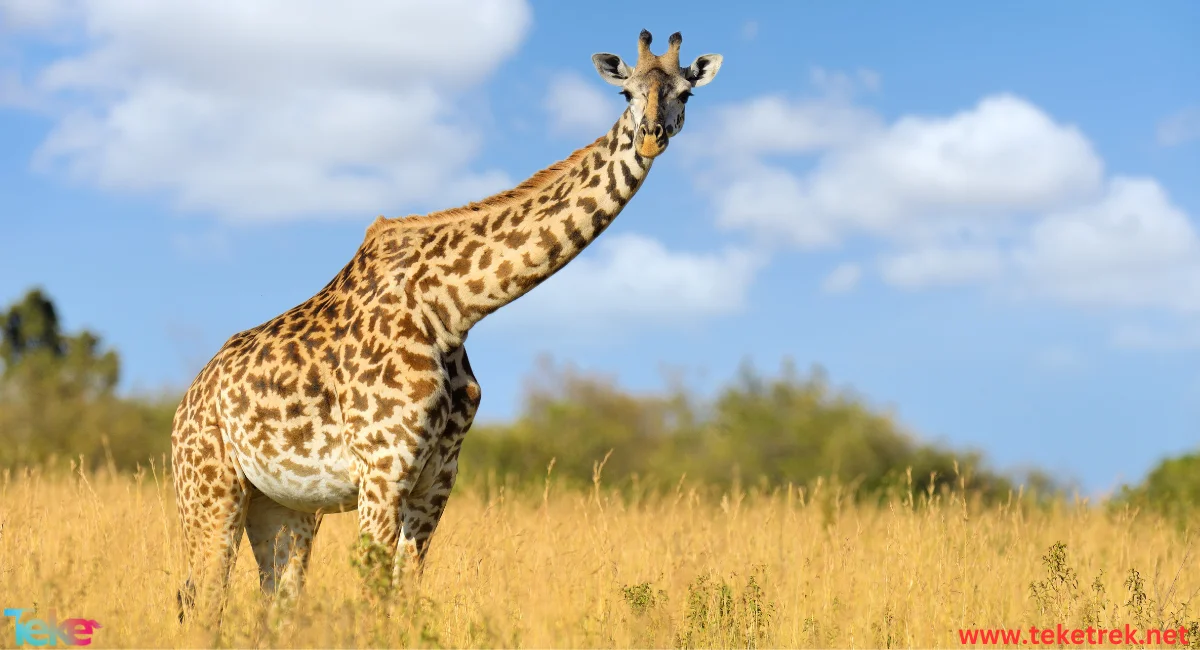This long-necked mammal inhabits the southern regions of the African deserts, thriving in vast savannas and grassy areas. It boasts a unique and impressive appearance, earning the gifraf the title of the tallest land mammal on Earth and marking it as a mythical creature.
The most important characteristics of the giraffe
The giraffe Scientific Name: Giraffa camelopardalis.
Length and Weight: The giraffe can reach a length of about 5.5 to 6 meters, with weights ranging between 800 and 1,200 kilograms.
Long Neck: The long neck is a distinctive feature of the giraffe, reaching more than half the length of its body. The giraffe’s neck can be approximately two meters long, composed of seven neck vertebrae.
Osseous Projections – Horns: The giraffe is characterized by the presence of horns on its head, appearing as bony projections covered with skin. The shape and size of these “ossicones” vary between males and females and among individuals.
Large Body: The giraffe’s body is robust and massive, covered in brown fur with shades ranging from dark brown to yellow and white.
Long Limbs: Giraffes have long, extended limbs that aid them in reaching high branches for feeding.
Large Ears: Giraffes feature large, round ears that help in listening and warning of dangers.

Long Tongue: Giraffes have a long tongue, approximately 45 centimeters in length, enabling them to reach high leaves in trees.
Big Eyes: Giraffes have large and prominent eyes located on the sides of their heads, providing them with a complete circular view of their surroundings due to their significant height. Their vision is acute, and they can distinguish colors.
Long Tail: Giraffes possess a long tail used for balance during movement and as a warning signal by swinging it vigorously. It ends with a tuft of dark hair, which they use to ward off flying insects.
Skin Patterns: Unique skin patterns on the giraffe’s body assist in camouflage and protection from the sun and insects.
Age: Giraffes in the wild typically live for a lifespan ranging between 20 and 25 years.
Cloven Hooves
- Giraffes have five toes on each front foot and four toes on each hind foot. These cloven hooves help them move steadily and maintain balance while walking. They also aid in reaching high tree foliage for food.
Does the giraffe have a voice?
- The giraffe can produce sounds, although it is generally considered a quiet animal, not emitting frequent noises like other animals.
- However, giraffes can occasionally make sounds. Males have deeper voices than females, and they may have vocalizations related to communication with peers or expressing emotions during mating periods or social interactions.
- Males, in particular, may emit a form of loud coughing sound. It has also been observed that females call their offspring through low grunts, and they may produce sounds similar to snoring, grunting, moaning, and bleating.
- Additionally, some giraffes have been heard hissing, groaning, and humming, while they communicate with each other over long distances using infrasonic waves that are inaudible to the human ear.
Habitat and locations of the giraffe
Giraffes inhabit the regions of Africa south of the Sahara Desert and are found in most countries in East and Southern Africa, including Kenya, Tanzania, Botswana, South Africa, and others. They thrive in grassy areas and open savannas, where they can find the necessary food, suitable breeding grounds, and living spaces. Giraffes prefer areas with dense trees that provide them with food, shade, and shelter from the sun.
Reproduction and behavior
- The reproduction process of giraffes occurs through natural birth, and the mating season is typically known to be from February to March in some regions. Mating usually involves the male selecting suitable females that are ready for mating, and this selection process continues for several weeks until the male finds a suitable mate.
- After a gestation period of about 15 months, the female usually gives birth to a single calf. The height of a newborn giraffe can reach around 1.8 meters. Giraffe births typically take place in the presence of a group of other giraffes that provide support and protection to the mother during the birthing process and the post-birth period. After giving birth, the mother continues to care for and protect the offspring for a period that can last up to two years.
- Females reach sexual maturity at around four years old, while males can attain sexual maturity at the age of four or five. However, they usually do not have mating opportunities until they are approximately seven years old.
Giraffe behavior and character
In general, giraffes are considered peaceful and non-threatening animals if they do not perceive any danger. Their behavior is characterized by calmness and humility, often living in small groups known as herds. However, when they feel threatened or under pressure, giraffes may exhibit defensive behavior that could involve the use of their horns in a destructive manner.
Overall, visitors typically have positive experiences when interacting with giraffes in zoos or wildlife reserves.
Difference between males and females
It is possible to distinguish between male and female giraffes based on some subtle differences in horn size and body conformation. Females are generally slightly smaller in size than males, and males tend to have thicker and longer horns.
Giraffe food
- The giraffe is a herbivorous animal that primarily feeds on tree leaves, branches, and fresh grass. It prefers leaves from trees with large foliage, such as acacias and thorn trees.
- A single giraffe can consume about 34 kilograms of plants daily. Giraffes rely on trees for food, water, and shelter, utilizing their long and specialized tongue to help in selecting and consuming high leaves.
- Additionally, giraffes may also consume some fruits, berries, and other herbs if available in their natural environment.
Speed
The giraffe exhibits a medium to slow speed, with an estimated average of around 50 kilometers per hour and the capability to run at speeds up to 60 kilometers per hour for short distances when necessary.
Giraffe species
Here is some important information about each type of giraffe:
1. Thornicroft’s Giraffe (Giraffa camelopardalis thornicrofti):
– Limited to the Luangwa Valley in eastern Zambia.
– Spots are unbranched and star-shaped, may or may not extend down the legs.
2. Masai Giraffe (Giraffa camelopardalis tippelskirchi):
– The Masai giraffe is native to central and southern Kenya and Tanzania.
– Characterized by a diverse coat pattern, with spots ranging from round and smooth to oval and jagged.
3. South African Giraffe (Giraffa camelopardalis giraffa):
– Found in northern South Africa, Botswana, and Mozambique.
– Dark spots on a fawn-colored background.
4. Angolan Giraffe (Giraffa camelopardalis angolensis):
The Angolan Giraffe is found in western and southern Zimbabwe, northern Namibia, southwestern Zambia, and central Botswana.
-It has large, irregularly shaped spots with rough edges.
5. Reticulated Giraffe (Giraffa camelopardalis reticulata):
– Found in northeastern Kenya, southern Ethiopia, and Somalia.
– Characterized by a distinctive coat pattern consisting of dark spots with sharp edges separated by thin white lines.
6. West African Giraffe (Giraffa camelopardalis peralta):
– Limited to the Luangwa Valley in eastern Zambia.
– Unbranched spots forming a star shape, may or may not extend down the legs.
7. Nubian Giraffe (Giraffa camelopardalis camelopardalis):
– Found in eastern South Sudan, southwestern Ethiopia, Kenya, and Uganda.
– Distinctive dark spots surrounded by clear white lines, with the lower part lacking spots.
8. Rothschild’s Giraffe (Giraffa camelopardalis rothschildi):
– Rothschild’s giraffe is native to parts of Uganda and Kenya.
– Characterized by large dark spots often with complete edges, but edges can also be sharp.
– Dark spots may contain light lines radiating from them or light lines inside them.
9. Kordofan Giraffe (Giraffa camelopardalis antiquorum):
– Found in southern Chad, central Africa, and northern Democratic Republic of the Congo.
– It has large, irregular spots.
– Spots may appear below the hooves and inside the legs.


The dangers and threats facing the giraffe
- Giraffes face environmental challenges such as habitat loss and degradation of wildlife areas, in addition to illegal hunting.
- Nature reserves and national parks in various African countries actively protect giraffes as part of global efforts to preserve biodiversity.
In conclusion, the giraffe is an integral part of African biodiversity, symbolizing beauty and excitement. By preserving these magnificent creatures and their natural habitats, we can ensure their continued existence for future generations and maintain the balance of the natural environment worldwide.






